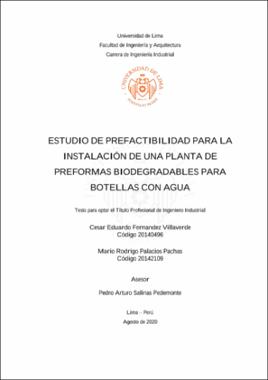Mostrar el registro sencillo del ítem
Estudio de prefactibilidad para la instalación de una planta de preformas biodegradables para botellas con agua
| dc.contributor.advisor | Salinas Pedemonte, Pedro Arturo | |
| dc.contributor.author | Fernández Villaverde, Cesar Eduardo | |
| dc.contributor.author | Palacios Pachas, Mario Rodrigo | |
| dc.date.accessioned | 2021-01-20T20:10:41Z | |
| dc.date.available | 2021-01-20T20:10:41Z | |
| dc.date.issued | 2020 | |
| dc.identifier.citation | Fernandez Villaverde, C. E. y Palacios Pachas, M. R. (2020). Estudio de prefactibilidad para la instalación de una planta de preformas biodegradables para botellas con agua [Tesis para optar el Título Profesional de Ingeniero Industrial, Universidad de Lima]. Repositorio institucional de la Universidad de Lima. https://hdl.handle.net/20.500.12724/12316 | es_PE |
| dc.identifier.uri | https://hdl.handle.net/20.500.12724/12316 | |
| dc.description.abstract | The objective of this research work is to determine the viability of a biodegradable preform production plant for bottles with water, evaluating the economic, technical and financial aspects. Most bottles are made of Polyethylene Terephthalate (PET), this material is polluting when it is incinerated, generating toxic gases; In addition, in natural conditions it can take 1,000 years to degrade. The study proposes that the bottles be made with polylactic acid (PLA), a degradable material in 80 days from vegetable waste. The target market is bottling companies, since preforms are the material they use for the production of their bottles. To determine the projected demand, an interview was conducted with one of the main bottlers: Ajeper S.A. For the location of the plant, a table of confrontation and ranking of factors at the Macro and Micro level was developed determining the location in Lima, Lurin. Plant size is established by analyzing the market, raw material requirement, technology and break-even point. The plant size was determined to be 12,295,619 preforms/year. Regarding the engineering of the project, the production process is similar to PET preforms; therefore, there is the necessary technology, which uses a semi- automatic injection machine. The production capacity of the plant is defined by the bottleneck, which is 27,144 boxes with PLA preforms, in order to determine how much the plant can produce in a given time. The administrative aspect is determined according to the functions that each part of the organization will have. The functions of the collaborators are described and the organization chart of the 19 collaborators is diagrammed. In the project evaluation, an economic NPV of S / .316.371 and a financial NPV of S / .393.023 were obtained. | en_EN |
| dc.description.abstract | El presente trabajo de investigación tiene como objetivo determinar la viabilidad de una planta productora de preformas biodegradables para botellas con agua, evaluando el aspecto económico, técnico y financiero. La mayoría de botellas son elaboradas de Tereftalato de Polietileno (PET), este material es contaminante cuando es incinerado, generando gases tóxicos; además, en condiciones naturales puede demorar 1,000 años en degradarse. El estudio propone que las botellas sean elaboradas con ácido poliláctico (PLA), un material degradable en 80 días proveniente de residuos vegetales. El mercado objetivo son las empresas embotelladoras, ya que las preformas son el material que utilizan para la producción de sus botellas. Para determinar la demanda proyectada se realizó una entrevista a una de las principales embotelladoras: Ajeper S.A. Para la localización de planta se elaboró una tabla de enfrentamiento y ranking de factores a nivel Macro y Micro determinando la ubicación en Lima, Lurín. Se establece el tamaño de planta analizando el mercado, requerimiento de materia prima, tecnología y punto de equilibrio. Se determinó que el tamaño de planta es 12,295,619 preformas/año. Respecto a la ingeniería del proyecto, el proceso de producción es similar a las preformas PET; por lo tanto, existe la tecnología necesaria, la cual se usa una máquina inyectora semiautomática.. La capacidad de producción de la planta se define por el cuello de botella, la cual es 27,144 cajas con preformas PLA, con el fin de determinar cuanto puede producir la planta en un determinado tiempo. El aspecto administrativo se determina según las funciones que tendrán cada parte de la organización. Se describe las funciones de los colaboradores y se diagrama el organigrama de los 19 colaboradores. En la evaluación del proyecto se obtuvo un VAN económico de S/.316.371 y VAN financiero de S/.393,023. Palabras clave: Preforma, ácido poliláctico. | es_PE |
| dc.description.uri | Tesis | |
| dc.format | application/pdf | |
| dc.language.iso | spa | |
| dc.publisher | Universidad de Lima | |
| dc.rights | info:eu-repo/semantics/openAccess | * |
| dc.rights.uri | https://creativecommons.org/licenses/by-nc-sa/4.0/ | * |
| dc.source | Repositorio Institucional - Ulima | |
| dc.source | Universidad de Lima | |
| dc.subject | Envases de plástico | es_PE |
| dc.subject | Agua | es_PE |
| dc.subject | Biodegradación | |
| dc.subject | Polietileno | |
| dc.subject | Plastic containers | |
| dc.subject | Water | |
| dc.subject | Biodegradation | |
| dc.subject | Polyethylene | |
| dc.title | Estudio de prefactibilidad para la instalación de una planta de preformas biodegradables para botellas con agua | es_PE |
| dc.type | info:eu-repo/semantics/bachelorThesis | |
| thesis.degree.level | Título Profesional | |
| thesis.degree.discipline | Ingeniería Industrial | es_PE |
| thesis.degree.grantor | Universidad de Lima. Facultad de Ingeniería y Arquitectura | |
| dc.publisher.country | PE | |
| dc.type.other | Tesis | |
| thesis.degree.name | Ingeniero Industrial | |
| renati.advisor.orcid | https://orcid.org/0000-0002-7021-1546 | |
| renati.discipline | 722026 | |
| dc.identifier.isni | 121541816 | |
| renati.author.dni | 71225042 | |
| renati.author.dni | 74048613 | |
| renati.level | https://purl.org/pe-repo/renati/level#tituloProfesional | * |
| renati.advisor.dni | 9138597 | |
| renati.type | https://purl.org/pe-repo/renati/type#tesis | * |
| dc.subject.ocde | https://purl.org/pe-repo/ocde/ford#2.11.04 | |
| ulima.cat | OI |
Ficheros en el ítem
Este ítem aparece en la(s) siguiente(s) colección(ones)
-
Tesis [1167]



